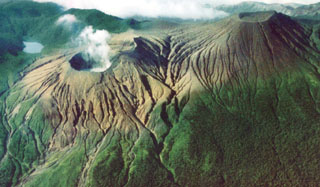Report on Rincon de la Vieja (Costa Rica) — 16 March-22 March 2016
Smithsonian Institution / US Geological Survey
Weekly Volcanic Activity Report, 16 March-22 March 2016
Managing Editor: Sally Sennert.
Please cite this report as:
Global Volcanism Program, 2016. Report on Rincon de la Vieja (Costa Rica) (Sennert, S, ed.). Weekly Volcanic Activity Report, 16 March-22 March 2016. Smithsonian Institution and US Geological Survey.
Rincon de la Vieja
Costa Rica
10.83°N, 85.324°W; summit elev. 1916 m
All times are local (unless otherwise noted)
OVSICORI-UNA reported that the seismic station located 1.8 km from Rincón de la Vieja recorded increased activity between late September and early November 2015, which became further evident in February 2016. Field investigations were conducted in February and March to assess this recent activity.
Between October 2015 and the first half of March 2016, the seismic network detected 69 events accompanying eruptive events though few of them and any resulting deposits were visually confirmed. Of the 69 events, seismic signals indicated that 28 of them occurred as a series of explosions during 17-18 October 2015, culminating with a major eruption at 0059 on 18 October. During February-15 March both the number of eruptive events and the energy of those events increased significantly; the data suggested that the events were phreatic. The two highest-energy events occurred at 0912 on 9 February and at 1354 on 9 March.
During fieldwork on 3 March, volcanologists found sediment deposits from the crater lake in an area about 200 m from the active crater, from phreatic activity and possibly strong westward-blowing winds. They heard three phreatic explosions, at 1204, 1209, and 1318; the third one was the strongest and lasted just over a minute. All three were followed by a strong sulfur dioxide odor. On 8 March volcanologists noted ash deposits, from recent weeks, as far as about 120 m from the crater rim covering an estimated area of 0.02 square kilometers. The temperature of the lake water was 45 degrees Celsius on average and 55 degrees in the convection cell. Gas measurements suggested a magmatic component, with a carbon dioxide to sulfur dioxide ratio of 2. The ratio of water vapor to sulfur dioxide was about 300, higher than the 100-200 ratio detected in previous years; degassing of the lake increased in March. Preliminary analysis of ash ejected during March activity suggested the possibility of a magmatic component. Photos from area residents of explosions during 9-10 March showed ash-and-steam plumes rising as high as 850 m above the crater.
Geological Summary. Rincón de la Vieja, the largest volcano in NW Costa Rica, is a remote volcanic complex in the Guanacaste Range. The volcano consists of an elongated, arcuate NW-SE-trending ridge constructed within the 15-km-wide early Pleistocene Guachipelín caldera, whose rim is exposed on the south side. Sometimes known as the "Colossus of Guanacaste," it has an estimated volume of 130 km3 and contains at least nine major eruptive centers. Activity has migrated to the SE, where the youngest-looking craters are located. The twin cone of Santa María volcano, the highest peak of the complex, is located at the eastern end of a smaller, 5-km-wide caldera and has a 500-m-wide crater. A Plinian eruption producing the 0.25 km3 Río Blanca tephra about 3,500 years ago was the last major magmatic eruption. All subsequent eruptions, including numerous historical eruptions possibly dating back to the 16th century, have been from the prominent active crater containing a 500-m-wide acid lake located ENE of Von Seebach crater.
Source: Observatorio Vulcanologico y Sismologico de Costa Rica-Universidad Nacional (OVSICORI-UNA)

